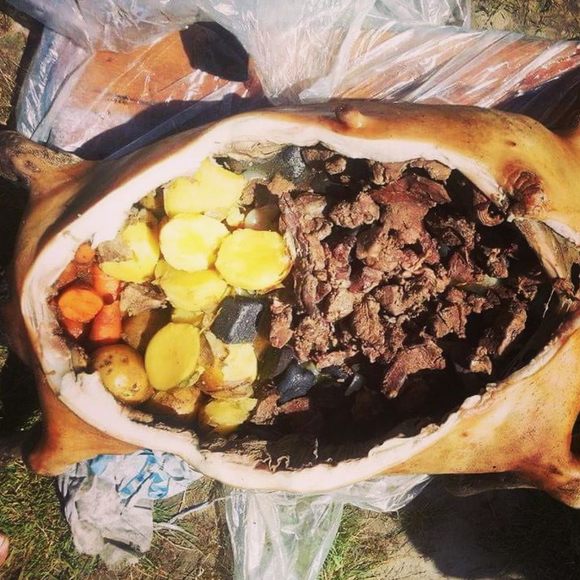Mongolian traditional clothes
The Mongolian traditional costume consists of a deel, a hat, boots, and accessories. There are differences between the costumes of the various ethnic groups, but all the deels have the same shape: long sleeves, a wide flap that gets folded up on the chest, buttons on the right shoulder, a high collar, and a fabric belt around the waist.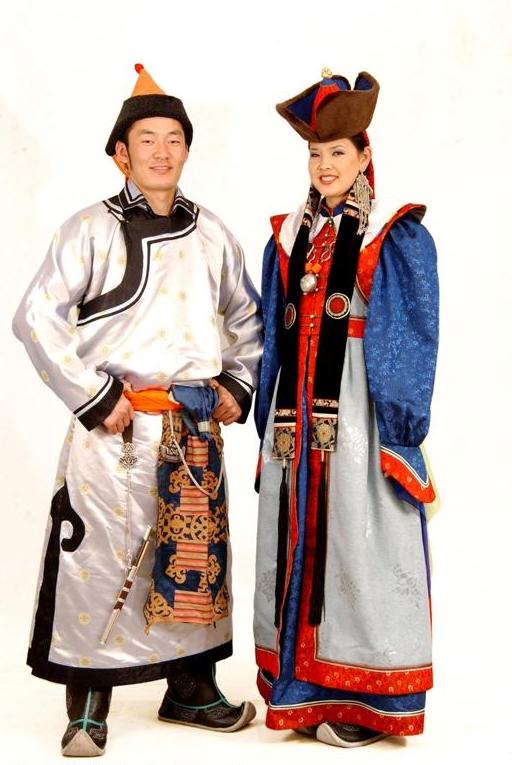
Hats:
One of the most colorful and original items of Mongolian national dress is the traditional head wear. The Mongolian head dresses differed in shape and purpose; there were hats for the young and old, summer and winter & men & women, holidays and ceremonies & fashionable and everyday hats. Their fashion and trimmings & colors were amazing varied depending on the sex of the person wearing it his or her social position or to who's tribe or nationality they belonged. In ancient times it symbolized power capable of frightening enemies. In summer Mongols wore either the hat or flat topped "toortsog" hat consisting of six gores. The toortsog had an upper and a lower part. The upper part was not one piece but was sewn from six separate pieces. Married women were not permitted to wear this hat only girls & men. The Shanaavch the temporal adornment with little silver bells was fixed to the hair holder. The tolgoin boolt was a headdress usually made of silver and studded with a precious stone and semiprecious stones. Women's hats were more fashionable than men's, and the ribbons on them were decorated with turquoise.
Deel:
The Deel is loose calf-length tunic made of one piece of material. It has long sleeves,a high collar and buttons on the right shoulder. The Deel buttons. If they are not commercially produced from decorative stones or silver, are narrow strips of cloth tied into intricate knots. Each ethnic group living in Mongolia has its own individual Deel , distinguished by its cut, color and trimming. These distinctions go unnoticed by foreigners but are obvious to Mongolians. Before Revolution, all social strata in Mongolia had their own manner of dressing. Live stock breeders for instance, wore yellow deels with a cape thrown over it. There are basically three types of deels, each worn during a particular season.The "Dan Deel" is made of light, thinks bright materials and is worn by women during the late spring and summer. The "terleg" is a slightly more padded version and both men and women. The winter Deel is serious, padded tunic lined with sheep skin, or layers of row cotton. The Deel for everyday wear is gray, brown or some other dark color, white the holiday Deel is a bright blue, green or claret silk with a silk sash of contrasting color several meters long.
Boots:
The toes of boots are upturned, and several explanations have been offered for this unconventional style. If boots had upturned toes pre 1578 when Buddhism introduced to Mongolia , then this would be an example of religion using indigenous customs, beliefs etc. to support advance their own religion. Another explanation is that the upturned tip prevents a rider's feet from slipping out of the stirrups.
Accessories:
Traditional accessories are usually maden by silver. Mongolian women usually wear a pearl headdressing and silver earrings with pearl. Necklace is not common.
Tsagaan sar moon festival
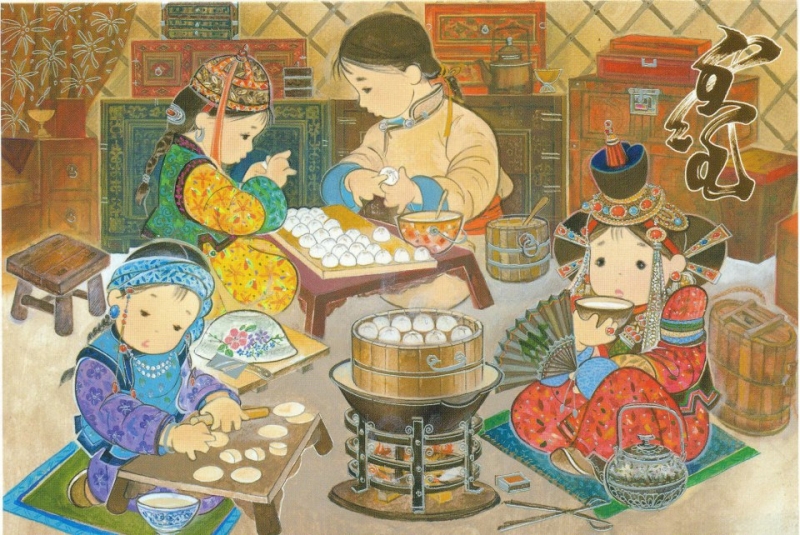 Tsagaan Sar, which literally means “White Moon”, is the biggest national and traditional holiday in Mongolia celebrated from the 13th century. In 1206, when Temujin established the Great Mongol Empire and proclaimed as the Chinggis Khan, he ordered to celebrate Tsagaan Sar in spring aiming to raise peace, kindness, and respect among the people. Mongols used to celebrate the holiday by wearing all white, riding white horse, eating white foods made by dairy products and exchanging white gifts.
Tsagaan Sar, which literally means “White Moon”, is the biggest national and traditional holiday in Mongolia celebrated from the 13th century. In 1206, when Temujin established the Great Mongol Empire and proclaimed as the Chinggis Khan, he ordered to celebrate Tsagaan Sar in spring aiming to raise peace, kindness, and respect among the people. Mongols used to celebrate the holiday by wearing all white, riding white horse, eating white foods made by dairy products and exchanging white gifts.
Tsagaan Sar symbolizes the first day of spring, when winter ends and the temperatures begin to get warmer. It corresponds to January or February in the Gregorian calendar, according to moon phases.
People start to prepare Tsagaan Sar many weeks before the beginning of the festival. Every family prepares hundreds of raviolis with meat called buuz,(dumpling) and the balconies become giant freezers. Buuz are the traditional dish for New Year. Families also prepare in advance the elegant clothes they’ll wear. Nomads prepare their best horses, because they’ll ride them during the festivities.
The day before Tsagaan Sar is called _”Bituun”_, which means “new moon”. All day long, Mongolians clean their house from top to bottom. Herders also clean the barn. Candles are lit to illuminate the Samsara and all the beings who reached the Buddha phase. Mongolians place three pieces of ice outside the door of their home, for the God Palden Lhamo’s horse to drink while the God is visiting the family. During the night, the families prepare a big dinner with much food. A great Mongolian wrestling competition is broadcasted on television. The families organize cards games because the persons who are lucky that night are supposed to be lucky all year long. People pay their debts and try to reconcile, in order to start the New Year under favourable auspices.
The morning of Tsagaan Sar, the hostess offers the first cup of tea with milk to the gods, throwing out the content in all directions. After daybreak, people begin greetings. Then they will have to go out in front of their house to perform the ritual prayers. These are published in the newspaper and are determined according to Chinese zodiac.
During the two days of Tsagaan Sar (and often during the following week), Mongolians visit their whole family ; they can visit ten families in one day. They always have to begin with the house of the oldest one, beginning with their parents’. Each visit is ritualized. When they arrive at their host’s, the latter is sitting in the Northern part of the yurt, keeping his hat on his head. They come and greet him according to the ritual called Zolgokh : guests come one after the other near the householder. The Khadag on the arms, the guest puts his forearm on those of his host, while uttering the phrase "amar baina uu? Sar shinedee saikhan shinelej baina uu", which means "do you live in peace ? Are you celebrating New Year in a good way ?". Then the host kisses him on both cheeks (or sniffs him), and the guest gives him money (new notes to mark the renewal, the amount depending on the importance of the host, but generally between 1000 and 20000 tugriks) and/or vodka. Then the guests sit around the table, where a steamed sheep, “_uuts_”, and a plate of traditional cookies, _”tsagaan sariin tavgiin idee”_, placed in stacked rows, and whose number is always odd, were placed. The hostess serves __tea with milk and traditional dishes. While the men exchange their snuffbox, people generally discuss the course of the winter. The guests drink three times, usually vodka.
After meal, when the guests are ready to leave, the host offers them a gift.
Mongolians attach great importance to the first day of the new year, because they think it affects the rest of the year. Thus, Mongolians have a religious ritual called "Khiymorio sergeekh" to call good fortune. During Tsagaan Sar, the Mongolians also follow the ritual of ovoo to thank gods and nature.
Welcome to Naadam Festival.
Naadam Festival is the only one of its kind; it is a sophisticated and eloquent expression of nomadic culture, it is the honored celebration of a national independence, and it is an outstanding combination of arts and sports.Even, the core of the festival – three manly sports – the wrestling, horseracing and archery, embrace many elements of arts, such as singing, dancing and performing.
Come travel to Mongolia with us to experience this Festival, which is the only one of its kind, in the world.
1. When is the Naadam Festival held?
Naadam Festival is Olympic Games of Mongols and held in the most enjoyable and festive month in the country. The main celebrations will be held annually on 11-13 July at Central Stadium and Khui Doloon Khudag in the country’s capital, Ulaanbaatar. But you have opportunity to enjoy the festival more closely with locals in other parts of the country hold their own as well.

2. WHY “THREE GAMES OF MEN”
Weird, but inspiring ‘Mongolia’s Three Games of Men’-Archery, Horse Racing and Wrestling are the main games. The origin of Naadam Festival is closely related to the history and culture of the country. It was one of the main practice of war. Before and after major battles, the three sports of men- wrestling, horseracing and archery- were exercised as an organized event, which later adopted its present name- Naadam. It is not only sports game including art, tricks, tactics but also ethic and cultural performance such as singing, dance, traditional costume, parade etc.
Mongolians revere certain parts of bones of their livestock and use them in religious rites, plays and traditional games.
In recent years Knuckle Bone Shooting- a team game getting popular and it became “Fourth” main sports of the festival. Teams of six to eight players flick thirty domino-like marble tablets on a smooth wooden surface towards a target of sheep knuckle-bones.
3. WHAT IS MONGOLIAN NATIONAL WRESTLING?
Wrestling is a unique combination of traditional sports manner and cultural elements of eagle dance, long song etc. It also has thousands of years of historical development in Mongolia.
Comparing to other wrestling competitions it has several specialty such as no time, space and weigh limit, 512 wrestlers are typically compete each other by tournament and this number increased to 1024 on the occasion of important anniversaries. Wrestlers must have strong discipline, moral and respectfulness to elders, high titled wrestler and audiences.
There are four main parts in the Mongolian Wrestling costumes including Four-sided hat, shoulder vest & snug shorts (Zodog & Shuudag), Cloak and traditional boots for using men only.
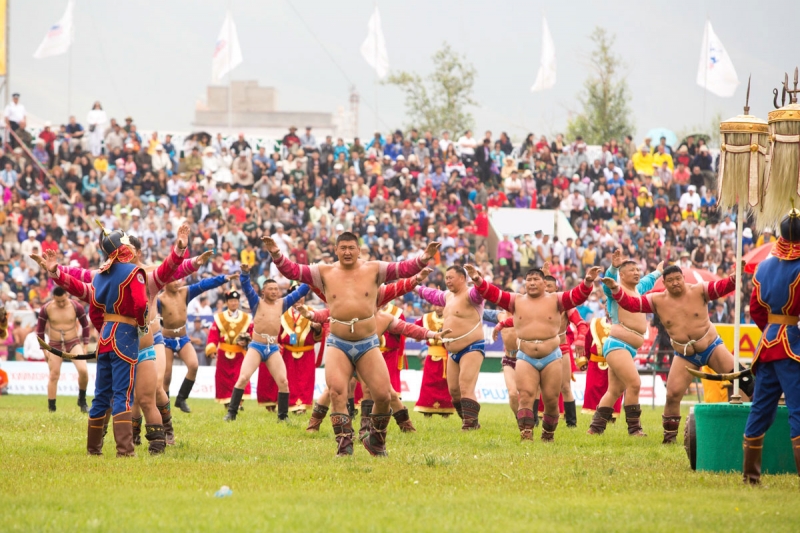
4. MONGOLIAN HORSE RACING
A horse role and culture is the biggest tradition of the Mongols in the daily and national life. Mongolians are said that “Nation born on horseback” and every child who grows in countryside learn to ride a horse when they are 3 to 5 years.
See the longest horse race ridden by children might not imagined.
Actually horse racing is scientifically sport and it races except winter time, when grass grows. To train a horse for race keeping under a special regimen at least one month before race and horse jockeys are usefully between 5 and 13 years of age and lead their horse across the steppes, over various distances between 10 and 26 km depending on horse age.
Soyolon- Five-years-old horse racing is most popular for locals and according to ancient Mongolian myth that says it is possible to charge its spirit and fortune by getting in touch with the whirled up dust and sweat of horse after racing.
Children sing a special song named GIINGOO, a mantra of GOD of HORSE- Khayankhyarvaa before and after racing.
Please notice that Horse Racing field is located 35 km from Ulaanbaatar named Khui Doloon Khudag, on the way you go to Khustai NP or Karakorum.
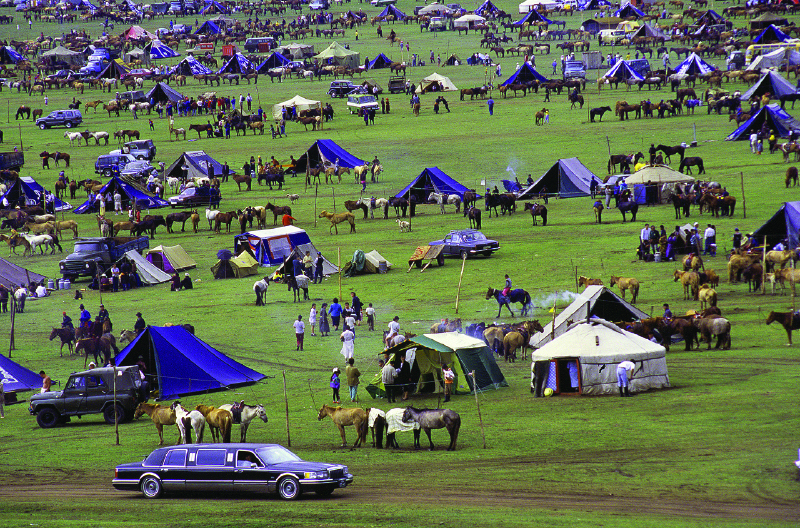
5. WHAT IS MONGOLIAN ARCHERY?
Due to its traditional lifestyle, ancient people used their version of bows and arrows for hunting and in later it started to be used as a weapon during the battle. During the Naadam Festival, all male, female and child archers who wears traditional costumes, compete in three categories: Khalkh, Buriad and Uriankhai archery, which have differences in the bows and arrows used, as well as the distance of the target. Archery is symbol of strength, vision, patience, sense and concentration. You can enjoy it outside of stadium, before opening ceremony starts, due to it starts early in the morning.
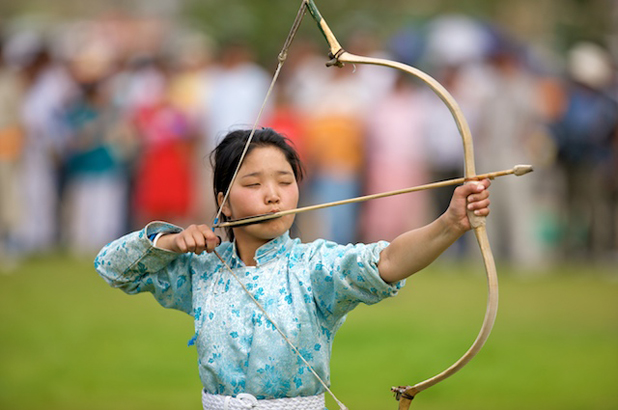
6. HOW THE OPENING CEREMONY GOES?
The opening ceremony starts at 11 A.M after “Nine White Banners” are carried by honored guard from Government Palace to be settled in the middle of Stadium and then the speech of President of Mongolia. Naadam Festival is very colorful event where people revive their Nomadic spirit, history and heritage. Opening ceremony has a great chance to enjoy and photograph Mongolian culture, art performances, song and dance, colorful parade, traditional costumes and miracles of Mongolian military force etc.
Everybody wears the most colorful and attractive traditional costumes with many different styles, like actors wear their best in Red Carpet of Oscars.
Photographers must buy a photo permission from Festival Organizer and it is allowed to photographing and video graphing in white lane. Therefore, please prepare zoom-lenses to capture more authentic photos.
After the ceremony ends Wrestling tournament will start. Most of the tourists enjoy opening ceremony and go to horse racing place.
7. A CHANCE TO EXPERIENCE OTHER CULTURAL EVENTS AT A SAME TIME
There are few cultural events will run under the Hospitable Ulaanbaatar Program between 10 and 15 of July annually. In the afternoon of 10th of July you will fully enjoy Mongolian Traditional Costume Festival- Deeltei Mongol, “Ceremony of Nine White Banners” and in the evening one of the Mongolian best operas “Uchirtai Gurvan Tolgoi-Three Dramatic Character” will be held in open air theatre at the central square.
In the night of 11th of July “Night of Ulaanbaatar”, Mongolian Dance Festival including modern and traditional dance show (12 Jul), Morin Khuur- Horse-headed Fiddle Festival (13 Jul), Ulaanbaatar Swing Night- Jaaz show (14 Jul)- the open air shows will be held in Sukhbaatar Square. Enjoy.
8. WHAT SURROUNDS CENTRAL STADIUM?
From a long time ago Naadam was only fest which gathering local people same time in same place. In the rest of the time nomadic people had very busy to visit each other and they only take care of their livestock, which is not easy job. When they gathered in same place they also do a barter, sell good and talk a gossip etc. Nowadays it is almost same in the area and surroundings of the Central Stadium is too crowd of people, bazaar, entertainment, lottery and food and beverage kiosks like a fair. For instance, if you forget to take your umbrella or sunglass you can buy it from local bazaar as cheap as you can.
TASTE TRADITIONAL MONGOLIAN FOODs & DRINKs
Of course you will ask what is the main dish of Naadam Festival? Definitely “round” KHUUSHUUR, fried dumpling is the main dish and once you taste it, you will never forget the taste and next time eager to eat it. At the stadium, good Khuushuur making kiosk has a queue and they make it quickly in front of you.
Drinking fermented mare’s milk- Airag also known as Kumis is the highlight of the Festival for locals. Because Airag appears only in summer time from June to September. Please don’t miss a chance to drink this alcoholic beverage nearly 5% alcoholic content.
HOW DOES IT TASTE? I want to say JUST DRINK IT.
9. JOIN LOCAL NAADAM FESTIVAL OUTSIDE OF ULAANBAATAR
Local Naadam Festival is more attractive for travelers, because of truly authentic, enthusiastic, no dramatic and allows you to experience first-hand by visiting locals. Here you can photograph and talk with locals without any prohibition. Mongolian traditional Ger dwelling used to be as restaurants in countryside. Most of the people ride a horse and run through the vast steppe without any traffic rule.
The festival is like a small fair. Local people come from all the province to either participate in the festivals to sell food and toys, or to run small carnival games for children and youngsters.
If you don’t like too touristic things LOCAL NAADAM is the best choice.
10. HOW TO BOOK HOTEL AND TICKETS OF NAADAM FESTIVAL?
July is the PEAK SEASON of tourists. While it is peak, the price of accommodation is doubled (desk rate price) and must book it at least 6 months before. Centrally located accommodation even guesthouses are fully booked in this time. Tour operator and local agents will be your reliable partner in the field.
Central stadium has 18 sections and four of them use for tourists. Nowadays booking a NAADAM TICKET by online is impossible. Ticket price for tourist section with roof is 25$, but you need to buy both opening and closing ceremony tickets. It will be sold a week before it runs and it is not easy to buy individually even for Mongolians.
Therefore, tour companies are best choice to book and arrange both accommodations, tickets and tour throughout Mongolia.
Ayan travel team is expert for arranging tours of Naadam festival which was named as Intangible Cultural Heritage of Humanity of UNESCO in 2010, as soon as you’re different interest, expectation of tour such as discovery and photography tours.
Mongolian barbecue Khorkhog & Boodog
The most typical and surprising dish of Mongolian cooking is certainly the traditional Mongolian barbecue.
This cooking method for meat is used for special occasions and the least we could say is that Mongolians are mad about it (and soon, you'll ask for some more too!). The basic technique consists in cooking the meat, mainly goat, mutton or marmot, on stones previously heated up directly in the fire.
For the khorkhog, the warm stones are placed with the meat and the vegetables (potatoes, carrots and cabbages) in a pot hermetically closed, then the whole is cooked on the fire for about 30 minutes.
For the boodog, the basic technique is the same, but instead of a pot, we place the stones, the meat and the vegetables in the previously cut up abdomen of the animal.
Honestly, cooking directly on the stones gives the meat a special and delicious taste. The meat lovers will love it, while the vegetarians will go on their way with no regret.
